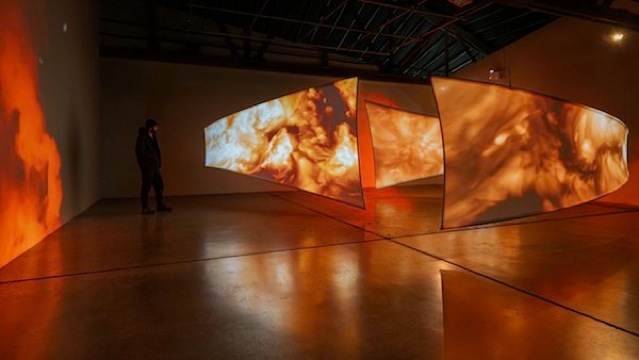video installations



Six-channel video installation
Three sculptural forms; three wall projections
17 minutes, continuous loop with soundscape
2024

BREATHING– LIGHT
Exhibit info: BREATHING- LIGHT | January 19 - March 10, 2024
Oregon Center for Contemporary Art | Portland, OR
Review: "Soak up the sun: Georgie Friedman," Oregon ArtsWatch, Feb 6, 2024
BREATHING– LIGHT is an experiential video and sound installation that ponders the enormity of the intangible: elements too small to see – too large to touch.
The complex movements within the Sun’s corona are visible as they rotate across three large, curved forms. Based upon how visitors navigate between the forms or position themselves in the space, the sculptural environment visually connects or separates. The shrinking and slicing of the Sun’s surface creates a scale shift. Either the Sun has shrunk to thirty-two feet wide,* or we’ve become approximately 20 Earths – 836,985,600 ft – tall. Simultaneously, volcanic smoke and formerly-tiny dust particles, encircle the space creating a connective atmosphere.
The elements of the Sun, on the Earth, and in our veins, can at times feel disparate, but when considered together, they are the tiny and immense things that connect us all.
DIMENSIONS
Site footprint: 36' x 35'
Walls: 12' to 17'
Curves: length | height change
-
•13' | 35" to 7' 10"
-
•16' | 6' to 22"
-
•13' | 8' to 32"
* The sun is 864,400 miles in diameter: about 109 times that of the Earth.
click to enlarge:

BREATHING- LIGHT, installation views, Oregon Contemporary, 2024
Sneak peek: Installation preview, 1:38 min, 2024. Full documentation forthcoming.
-
•Georgie Friedman researched, compiled, and animated over 24,000 photographs of the Sun to create the videos in this exhibit.
-
•The Sun images are courtesy of NASA/SDO (Solar Dynamics Observatory) and the AIA, EVE, and HMI science teams.
-
•The imagery is from December 2023 at the wavelength of 193 Ångstroms.
-
•Footage of the volcanic smoke and dust particles was filmed by Georgie Friedman.
-
•The soundscape was created in collaboration with Radio Sloan.


CREDITS / INFO
-
The imagery of the Sun used in this exhibit was recorded via the extreme ultraviolet (EUV) wavelength of 193 Ångstroms (19.3 nanometers) which highlights a spectral line emitted by iron atoms that have lost 11 electrons (also known as iron-12 or Fe XII) at temperatures of 1,000,000 K as well as iron atoms that have lost 23 electrons (also known as iron-24 or FeXXIV) at temperatures of 20,000,000 K. The former represents a slightly higher region of the corona and the latter represents the much hotter material of a solar flare.
-
This wavelength also makes coronal holes (which appear as dark regions near the solar surface) more visible. Coronal holes are the cooler areas from which solar wind streams into space at high speed.
all images, video, and other content © georgie friedman unless otherwise noted